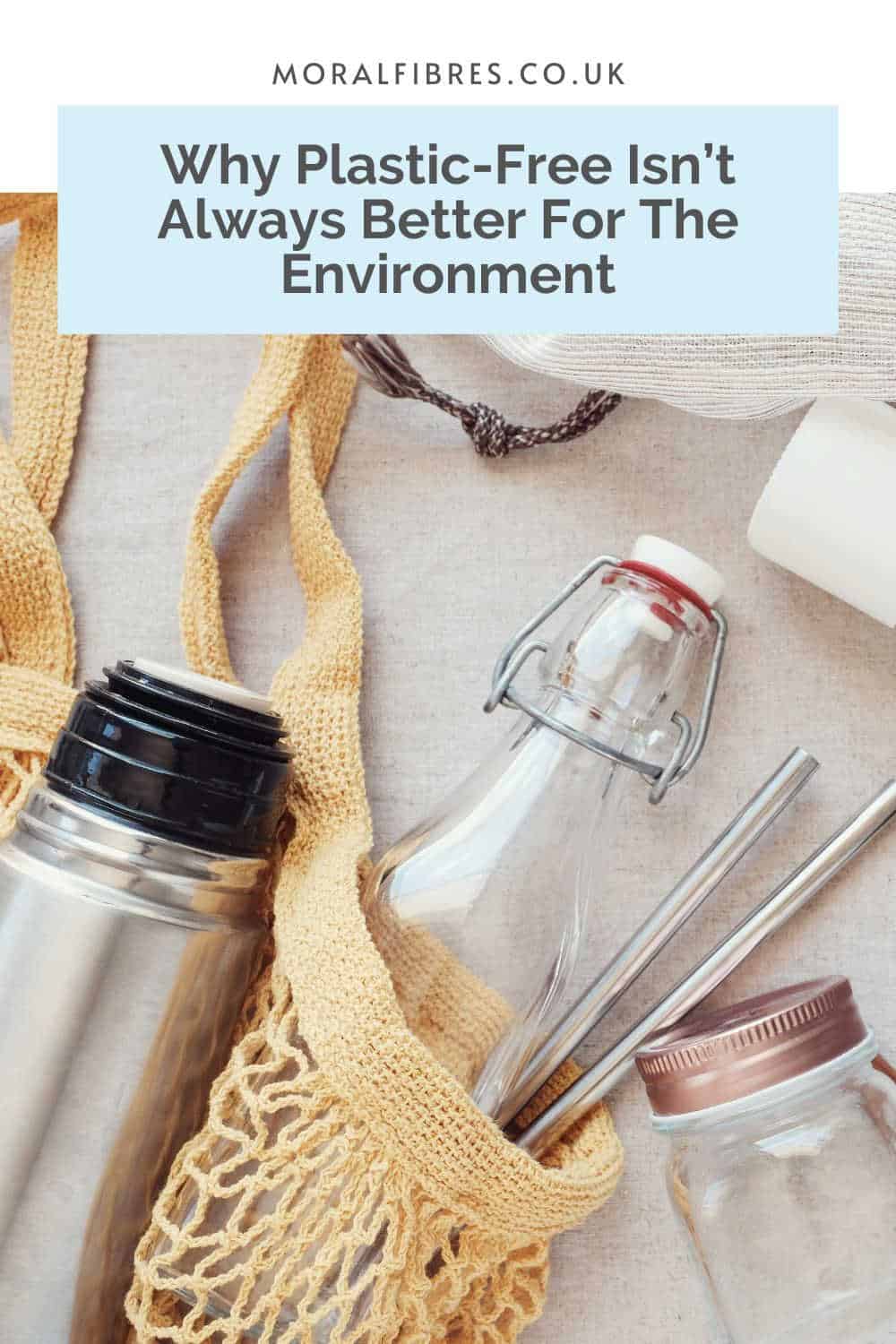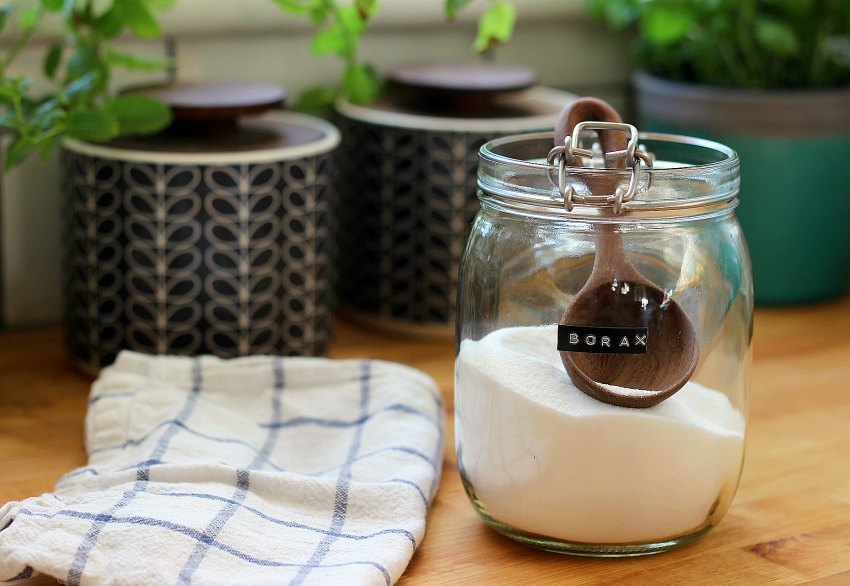Why Plastic-Free Isn’t Always Better For the Environment
To support the running costs of Moral Fibres, this post may contain affiliate links. This means Moral Fibres may earn a small commission, at no extra cost to readers, on items purchased through these links.
A recent post I wrote on plastic-free toilet paper sent a few of you into a spin. Many of you didn’t realise that recycled toilet paper that’s made in the UK or EU and wrapped in plastic has a lower carbon footprint than plastic-free toilet paper made from recycled paper or bamboo that’s shipped from China.
It’s not just toilet paper. A recent study showed that a paper bag has to be re-used four times before it’s more environmentally friendly (in terms of carbon emissions) than a plastic bag. Meanwhile, a reusable cotton bag must be used a staggering 131 times before it has a lower carbon footprint (and therefore, lower global warming potential) than a plastic bag.
Now take a basket of plastic-free fruit and vegetables that are flown in from Egypt or South America. These are going to, mostly, have a higher carbon footprint than seasonal UK produce wrapped in plastic. Plastic that’s often there in the first place to prolong freshness and prevent food waste.
Mind-blowing, isn’t it? Just how do we navigate this minefield? Let me help.
Sustainability & Nuance

The carbon footprint of packaging is only about 10% of the food we eat. It’s a tricky one to get your head around that plastic-free isn’t always equal to better for the environment.
What this means is that sustainability is a lot more nuanced than just saying plastic is bad, whilst paper, glass, cardboard, cotton, and other natural materials are good.
Plastic reduction is a great entry point to sustainability. This is because plastic is a very visible reminder of our impact on the environment. However, there’s also a whole lot more at play, and the problem at hand is too important to allow plastic to be the limit of our work to reduce our impact on the environment.
Whilst reducing plastic is important for our physical environment, we also need to look at other issues in parallel. These issues, in the case of toilet paper or fresh produce, include the impact of shipping goods from the other side of the globe. However, they also concern our consumption patterns and the impacts on climate change.
Not sure what this should look like? A recent study showed the six most impactful changes we can make to help limit the climate crisis. Note that reducing plastic isn’t on there, but it often goes hand in hand with reducing our consumption of stuff.
Sustainability & Privilege
The other bigger problem is by saying that sustainability is all about plastic, this immediately dismisses and disengages many. This includes the large percentage of people who due to disability can’t prepare fresh vegetables. Or the percentage of the population that can’t afford the often costlier plastic-free options. And those who don’t have access to plastic-free options, such as bulk shops.
By saying that sustainability is all about being plastic-free, sustainability becomes an unwelcome tool to segregate and divide society. It becomes a big blinking neon beacon of privilege, at a time when we need everyone to work together.
What does this mean in terms of decision-making when we need to buy things? How do we navigate this minefield that sometimes plastic-free isn’t always better?
A single blog post on how to navigate life would be overwhelming. But I thought that taking one bit of it might be helpful. I’m taking the bit I get asked about the most often – food shopping. There are lots of lessons we can learn from the food that we buy that we can then apply to other aspects of life.
Lower Carbon Food Shopping
So let me share my approach to lower-carbon food shopping. It’s one rooted in a wholly imperfect food system. Then I want to look at the lessons from that, that can be applied to life in general:
My Approach To Lower Carbon Food

I’m limited in what produce we can buy because I live in a less well-off area, where 1 in 4 children live in poverty. This means there are no zero-waste stores.
The fact that 1 in 4 kids lives in poverty upsets me 100% more than the fact that there are no zero-waste bulk shops near me. I’d rather everyone could eat and not have to rely on food banks rather than there being a zero-waste shop in our area that only a privileged few could afford to shop at. Wringing my hands over a lack of zero-waste places to shop seems like a privilege too far, so I don’t.
For me to visit a zero-waste shop would necessitate a 24-mile round trip to my nearest zero-waste shop. The time, money and extra fuel involved to do so means I don’t. So this is my approach to low-carbon food at the supermarket. I’m not perfect. Our food systems aren’t perfect. And your food shopping processes might look different depending on what you have access to, and on your capacity. But let’s give this a go:
Fruit & Veg
- I try to buy loose seasonal UK fruit and vegetables in the supermarket. If there is only UK seasonal produce wrapped in plastic then I’ll opt for that. This is because the carbon footprint of plastic packaging is often (but, for an added complication, not always!) far less than that of unpackaged fruit and vegetables shipped from places like Chile.
- If there are wonky fruits and vegetables available, then, regardless of where they have come from and how they are packaged, then these are a good buy. This is because these are fruits and vegetables that would otherwise be discarded (i.e. binned) because they are not deemed “perfect” enough for consumers.
- With fruit that comes in a bunch, e.g. bananas, I try to buy the single ones, rather than immediately reaching for the ones already in a bunch. It’s been found that shoppers are less likely to choose single bananas. As such, these often get left behind and binned. Bananas have a surprisingly low carbon footprint (told you it’s complicated!).
- We often buy canned vegetables, such as mushrooms. This is because we found when we bought fresh mushrooms these often went off in the fridge as we didn’t use them all in time. Now when we make vegan chilli or stew we use a whole can of mushrooms with no food waste. Alternatively, you can also dry mushrooms to help reduce waste.
- If you need to opt for pre-prepared vegetables wrapped in plastic because of circumstance then you do that and do not ever feel guilty.
Packaged Food
- Vegan food packaged in plastic has a significantly lower carbon footprint than meat that you can buy unpackaged from the butcher. Particularly beef and lamb.
- The reduced section is a great place to buy any food, even meat if you eat it, particularly at the end of the day. This is because a) it’s generally very cheap and b) if you don’t buy it then it’s probably going to go in the bin. Not composted. Just straight in the bin, where it will create methane, which has a global warming potential that’s around 84 times higher than that of carbon dioxide. Of course, it’s only a good buy if you are actually going to eat it. Either make sure you eat it that day or check the label to see if it’s freezable, If so, freeze it and eat another day. If not, leave it for someone else who may appreciate it more.
- As working parents, we don’t always have the time or energy to cook every meal from scratch. In the frozen section, a lot of vegetarian and vegan produce comes in cardboard boxes. I like to keep boxes of Quorn vegan fishless fingers to hand, for example, for those evenings.
- At the moment I am buying staples such as pasta and rice in plastic because of a lack of other options. I try to buy the biggest bags I can to reduce plastic in that way. Sometimes I find Barilla pasta that comes in a cardboard box, but otherwise, I don’t sweat it.
Other Food & Shopping Tips
- Taking my own bags and produce bags and remembering to use them is super important. Remember it takes 131 uses before a cotton bag has less global warming potential than a plastic bag.
- Meal planning is king. Having an idea of what you are going to cook is a good idea so you only buy what you need.
- Repurposing leftovers and having them for lunch the next day or dinner the next evening, or freezing for later, is key to avoiding waste, and saving money. If food waste were a country, scarily it would be the third-largest behind the US and China in terms of global warming potential.
- With that in mind, getting creative with food waste is a good idea, and composting anything unused, if possible,
- We bought a cheap slow cooker a couple of years ago. This makes cooking from scratch a whole lot easier on the days when we are both at work. We can pop it on in the morning if we’re not running around like headless chickens trying to get everyone out of the door and to the right place on time. Then we can return home in the evening to a home-cooked meal that’s low on packaging. If there are leftovers then that’s lunch for the next day, or a meal for the freezer.
- I’m not always the best at this, but following on from this, taking lunch to work means I can make something vegan. Vegan takeaway options can really be hard to find in the town where I work. It also means I can save on packaging.
I’m sure there are a hundred thousand other tips on low-carbon food and eating. It’s easily a subject for an entire book, but this is my general philosophy towards food.
Key Lessons
How this discussion on food fits into the wider issue of environmentalism is that I hope it shows how a bit of pragmatism is needed. And that this pragmatism can be applied to all aspects of life:
- Consuming only what we need is probably the biggest thing we can do, in all aspects of life, to be more sustainable.
- Thinking about where an item has been made and shipped from and the emissions involved is an important consideration. This can be complex. I found this book – How Bad Are Bananas incredibly helpful.
- Plastic-free doesn’t always mean better. It’s a great place to start but our environmental activism can and should extend beyond just a focus on plastic.
- This doesn’t give us carte blanche to go mad on plastic. Reducing plastic where we practically can is still important. This is because of its impacts on the physical environment and marine life.
- Reusing what we have and reducing waste, particularly food waste, is incredibly important and should not be underestimated.
- Just because something doesn’t look perfect doesn’t mean it’s not valuable.
- Remember that not everyone has equal access/opportunities/abilities so everyone’s actions will look different.
It’s certainly all food for thought. My hope is that these tips will help guide you through any purchasing decisions.
Maybe you have any other tips you would add? Maybe you have some you disagree with? Or maybe I’ve fried your brain? Either way, let’s chat!
Found this post useful? Please consider buying me a virtual coffee to help support the site’s running costs.




